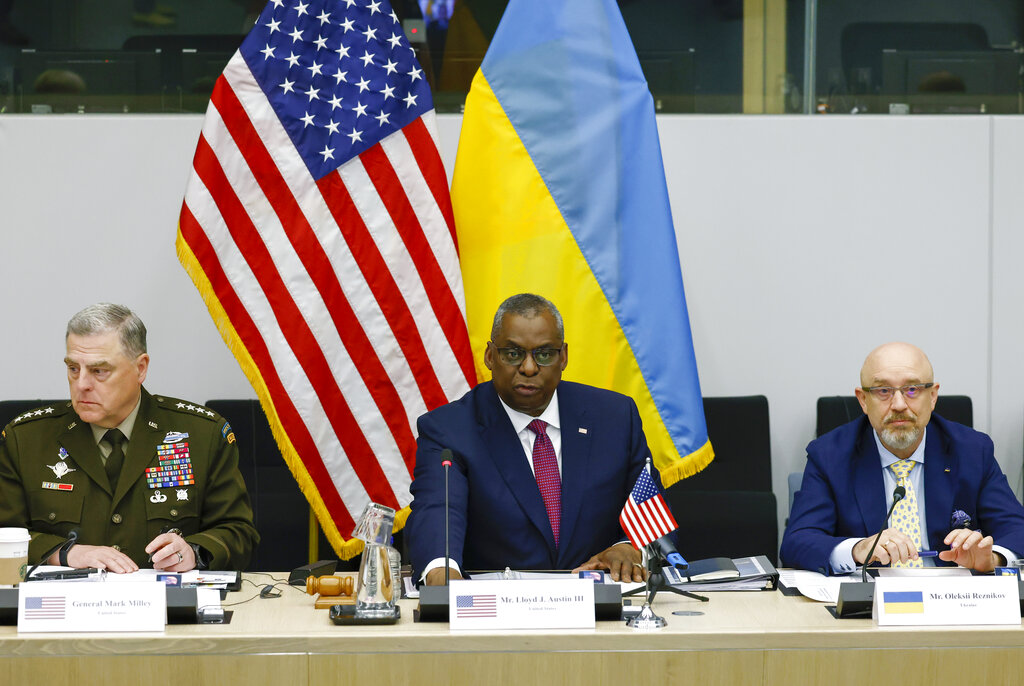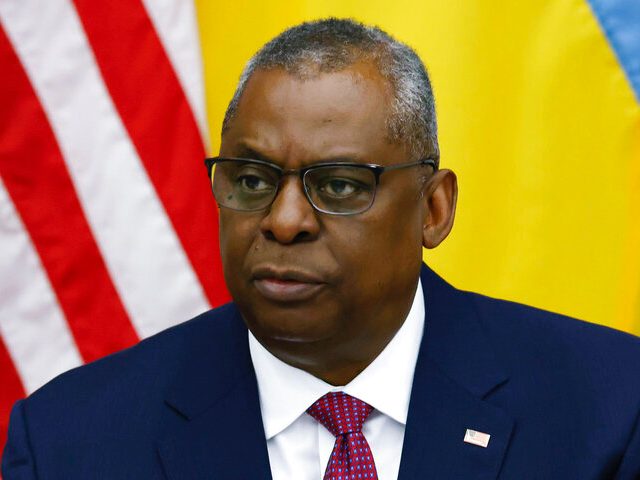Defense Secretary Lloyd Austin announced another $1 billion in military aid for Ukraine on Wednesday, following the third meeting of the Ukraine Defense Contact Group, a group of about 50 nations supporting Ukraine in its war against Russia.
“I’m especially pleased to be able to announce today that the United States will provide an additional $1 billion security assistance package for Ukraine,” Austin said at a press conference at the NATO headquarters in Brussels, where the members of the group met.
A portion of the $1 billion — $350 million — will come from the Pentagon’s existing stocks, and the remaining $650 million will come from the $40 billion that Congress passed for Ukraine security and humanitarian assistance last month.
Austin said the latest package of military aid includes guided multiple launch rocket systems (MLRS) munitions, 18 more M777 howitzers and the tactical vehicles to tow them, and 36,000 rounds of 155mm ammunition. It also includes two additional Harpoon coastal defense systems and thousands of secure radios, night vision devices, thermal sights, and other optics.
Earlier this month, Biden authorized four High Mobility Artillery Rocket Systems (HIMARS) with guided MLRS munitions, Javelin anti-tank missiles, helicopters, counter-battery radars, and ammunition.

Members of the 2nd Stryker Brigade Combat Team fire a Javelin missile from a Stryker Infantry Carrier Vehicle during a live-fire training exercise on April 28, 2022, in Fort Carson, Colorado. The U.S. military has sent almost a third of its javelin missile supply to Ukraine. (Michael Ciaglo/Getty Images)
Austin also said Germany announced it would provide three MLRS and guided MLRS munitions, Slovakia would donate helicopters and urgently needed rocket ammunition, and Canada, Poland, and the Netherlands would donate artillery.
“Now, these are key investments in Ukraine’s long-range fires capabilities, and they’ll be crucial to Ukraine’s efforts to repel Russia’s assault in the Donbas,” Austin said.
Asked how long the group could maintain support for Ukraine, Austin responded, “We will stay focused on this for as long as it takes.”
The war began on February 24 and has now lasted more than 100 days. After launching attacks around the country, including on the Ukrainian capital of Kyiv, Russian forces are now focused on seizing Ukrainian territory in the east. As Russian forces have made gains, appeals from Ukrainian officials for long-range artillery have grown more urgent.
Chairman of the Joint Chiefs of Staff Gen. Mark Milley, who appeared alongside Austin, said that the HIMARS systems, ammunition, and trained crews would be transferred to the Ukrainian battlefield “by the end of this month.”

From left, U.S. Chairman of the Joint Chiefs of Staff General Mark Milley, U.S. Defense Secretary Lloyd Austin, and Ukraine’s Defense Minister Oleksii Reznikov attend the Ukraine Defense Contact group meeting ahead of a NATO defense ministers’ meeting at NATO headquarters in Brussels, Wednesday, June 15, 2022. (Yves Herman, Pool Photo via AP)
He said the U.S. and other countries are trying to build a platoon at a time to make sure Ukrainian forces can properly employ and maintain the systems.
He said to date, 420 Ukrainians have been trained on the M777 howitzers, 300 on the self-propelled M109, 129 on the 113 armored personnel carrier, 100 on unmanned aerial systems, and 60 on the HIMARS.
“In a few weeks, the Ukrainians will have trained, long-range rocket artillery in the fight,” Milley said.
Milley sought to quell criticism that U.S. weapons transfers have been too few or too slow.
He said the U.S. has provided over 6,500 Javelins and 20,000 other anti-armor systems and that the international community has provided almost 97,000 anti-tank systems, which he said were “more anti-tank systems than there are tanks in the world.”
He said the U.S. has also provided over 1,500 stingers, more than 700 Switchblade tactical unmanned aerial systems, 20 Mi-17, thousands of small arms, and hundreds of thousands of small arms ammunition.
“The speed that we have delivered security assistance is without comparison. From the time the requests are validated and authorized it is only a matter of days until the requirement is sourced, shipped, in the hands of Ukrainians. In some cases, it may take a week, but most of the time it’s measured in days,” he said.
“We are supporting the Ukrainian military as rapidly as humanly possible,” he added.
Milley acknowledged, however, that Russians had an advantage over Ukraine in artillery.
Milley claimed the “rules-based international order” was under threat.
“Ukraine is under threat. They are at war and we will continue to support them. But the rules based international order is also under threat due to the actions of Russia in the Ukraine,” he said.
“The international community is not allowing this unambiguous act of aggression by Russia to go unanswered. To do so risks the world returning to an era when large powerful countries can invade smaller countries at will.”
Milley continued:
There are no inevitabilities in war. War takes many, many turns, so I wouldn’t say it’s an inevitability, but I would say that the numbers clearly favor the Russians. In terms of artillery, they do outnumber, they out-gun and out-range. You’ve heard that many, many times — and they do have enough forces. But there’s — the Russians have run into a lot of problems. They’ve got command-and-control issues, logistics issues. They’ve got morale issues, leadership issues and a wide variety of other issues.
So the Ukrainians are fighting a heroic fight. This fight down in the Donbas has been going on since 16 April, and the advances that the Russians have made have been very slow, a very tough slog, very severe battle of attrition, almost World-War-I-like, and the Russians have suffered a tremendous amount of casualties,” he said.
Milley acknowledged that the U.S. assesses that Ukrainian casualties are in the ballpark of 100 troops killed and between 200 to 300 wounded a day.
Follow Breitbart News’s Kristina Wong on Twitter or on Facebook.

COMMENTS
Please let us know if you're having issues with commenting.